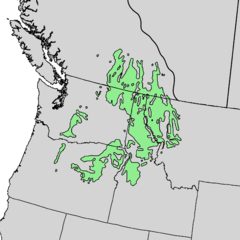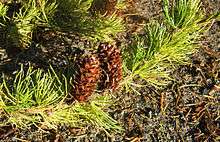Larix occidentalis
| Western larch | |
|---|---|
| | |
| William O. Douglas Wilderness | |
| Scientific classification | |
| Kingdom: | Plantae |
| Division: | Pinophyta |
| Class: | Pinopsida |
| Order: | Pinales |
| Family: | Pinaceae |
| Genus: | Larix |
| Species: | L. occidentalis |
| Binomial name | |
| Larix occidentalis Nutt. | |
 | |
| Natural range of Larix occidentalis | |
Western larch (Larix occidentalis) is a species of larch native to the mountains of western North America, in Canada in southeastern British Columbia and southwestern Alberta, and in the United States in eastern Washington, eastern Oregon, northern Idaho, and western Montana.

It is a large deciduous coniferous tree reaching 30 to 60 metres (98 to 197 ft) tall, with a trunk up to 1.5 metres (4.9 ft) diameter. The largest known western larch is 153 feet (47 m) tall and 22 feet (6.7 m) in circumference with a 34 feet (10 m) crown, located at Seeley Lake, Montana. The crown is narrow conic; the main branches are level to upswept, with the side branches often drooping. The shoots are dimorphic, with growth divided into long shoots (typically 10 to 50 centimetres (3.9 to 19.7 in) long) and bearing several buds, and short shoots only 1 to 2 millimetres (0.039 to 0.079 in) long with only a single bud. The leaves are needle-like, light green, 2 to 5 centimetres (0.79 to 1.97 in) long, and very slender; they turn bright yellow in the fall, leaving the pale orange-brown shoots bare until the next spring.
The seed cones are ovoid-cylindric, 2 to 5 centimetres (0.79 to 1.97 in) long, with 40 to 80 seed scales; each scale bearing an exserted 4 to 8 millimetres (0.16 to 0.31 in) bract. The cones are red when immature, turning brown and the scales opening flat or reflexed to release the seeds when mature, four to six months after pollination. The old cones commonly remain on the tree for many years, turning dull gray-black.
It grows at 500 to 2,400 metres (1,600 to 7,900 ft) altitude, and is very cold tolerant, able to survive winter temperatures down to about −50 °C (−58 °F). It only grows on well-drained soils, avoiding waterlogged ground.
The seeds are an important food for some birds, notably pine siskin, redpoll, and Two-barred crossbill.
Uses
Some Plateau Indian tribes drank an infusion from the young shoots to treat tuberculosis and laryngitis.[1]
The wood is tough and durable, but also flexible in thin strips, and is particularly valued for yacht building; wood used for this must be free of knots, and can only be obtained from old trees that were pruned when young to remove side branches. Small larch poles are widely used for rustic fencing.
Western larch is used for the production of Venice turpentine.
The wood is highly prized as firewood in the Pacific Northwest where it is often mistakenly called "tamarack," although it is a different species than the tamarack larch. The wood burns with a sweet fragrance and a distinctive popping noise.
Indigenous peoples used to chew gum produced from the tree as well as eat the cambium and sap.[2]
References and external links
![]() Media related to Larix occidentalis (category) at Wikimedia Commons
Media related to Larix occidentalis (category) at Wikimedia Commons
- ↑ Hunn, Eugene S. (1990). Nch'i-Wana, "The Big River": Mid-Columbia Indians and Their Land. University of Washington Press. p. 354. ISBN 0-295-97119-3.
- ↑ Turner, Nancy J. Food Plants of Interior First Peoples (Victoria: UBC Press, 1997) ISBN 0-7748-0606-0
- Conifer Specialist Group (1998). "Larix occidentalis". IUCN Red List of Threatened Species. Version 2006. International Union for Conservation of Nature. Retrieved 12 May 2006.
- Gymnosperm Database: Larix occidentalis
- Flora of North America: Larix occidentalis
- USDA Plants Profile: Larix occidentalis
- National Register of Big Trees – American Forests
